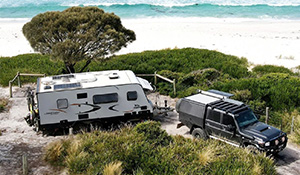ADVICE – Monocoque 4x4s explained
The benefits of monocoque construction for 4x4s remains open to debate. While monocoque construction has become more commonplace these days, even on hard-core 4x4s, some remain unconvinced as to its merits against “traditional” body-on-frame construction. The debate over which of the two platfoms is better continues, but here are some facts.

In the late 1990s, Mitsubishi introduced the Pajero NM, a model that caused quite a stir in the automotive world due to its monocoque construction. By this stage, monocoque (where the body and chassis are one unit) was the norm for passenger cars, but not 4x4s. The prevailing belief was that the rugged roads and conditions such vehicles were exposed to required tougher body-on-frame construction.
Mitsubishi’s departure from this tradition was significant and the Pajero NM became one of the first mainstream 4x4s to buck accepted thinking. The new-generation Land Rover Defender that arrived in 2020 has also chosen to go with monocoque construction. Is this worse than body-on-frame? Does it make the Defender and other monocoque 4x4s less competitive? Misconceptions about this form of vehicle construction persist.

What’s the difference between monocoque and body-on-frame?
Imagine a traditional house with a solid, heavy steel frame. This frame is like a skeleton that supports all the parts attached to it - walls, roof, windows and doors. Robust and durable, this design is much like the body-on-frame construction in vehicles. However, the separate frame and additional components make the house heavier and more complex to build and maintain.
Now, think of a modern skyscraper. In this structure, the exterior walls are not just coverings but also integral parts of the building’s support system. The entire structure, including the walls, floors and roof, work together to bear loads. This method uses materials efficiently, reducing overall weight while maintaining strength and rigidity.

The Shift to Monocoque
When monocoque chassis designs began appearing on 4x4s like the Pajero, it led to some confusion. A true monocoque structure relies almost entirely on its skin for strength, which isn’t practical for cars due to the likelihood of damage. Instead, most “monocoque” 4x4s use a reinforced chassis integrated with the body, known as unitary construction or unibody. This design combines the body and chassis into a single unit, offering greater rigidity and reduced weight, but retains some attached panels to make repair simpler and easier.

Understanding Unibody 4x4s
The new Land Rover Defender uses a 100 per cent aluminium monocoque. This advanced material choice provides an excellent strength-to-weight ratio, corrosion resistance and durability.
In practical terms, unibody vehicles can’t have their bodies easily swapped like separate-chassis vehicles because the body is integral and thus contributes to the vehicle’s strength and rigidity. However, this doesn’t make them weak.
Modern unibody vehicles have a robust chassis and are often stronger than older separate-chassis designs. While the body contributes to overall rigidity, most strength still comes from the chassis, so the design can handle minor damage without compromising the vehicle’s structural integrity.

Engineering Enhancements
Recent advances in computer-aided design (CAD) and finite element analysis (FEA) have allowed engineers to optimise unibody structures to an unprecedented degree. Using these tools, vehicle manufacturers can predict how different parts of the body and chassis will respond to various stresses and strains, ensuring that the unibody is not only lighter but also more robust.
Additionally, modern manufacturing techniques like hot stamping and hydroforming allow for the creation of complex shapes and reinforcements within the unibody structure. These techniques improve the overall strength and safety of the vehicle, allowing for better performance in crash tests and increased durability in off-road conditions.

Recovery and Practical Use
Concerns about using recovery points on unibody vehicles are largely unfounded. Properly designed unibody 4x4s have recovery points connected to the chassis, ensuring safe winching and snatching. That being said, misuse of recovery points can cause damage, regardless of whether the vehicle is a unibody or separate-chassis type.

Practical Benefits
Unibody construction also allows for better noise, vibration, and harshness (NVH) control, providing a more comfortable ride for passengers. The integrated design means fewer joints and connections that can rattle or transmit vibration. Furthermore, the increased rigidity of the unibody structure improves handling and responsiveness, making modern 4x4s constructed this way more agile - on and off the road.

Versatility and Adaptability
Modern unibody 4x4s are designed with versatility in mind. The unibody framework supports advanced suspension systems, which can be tuned for various driving conditions, from smooth highway cruising to rugged off-road trails. The flexibility of the unibody design also allows manufacturers to incorporate the latest safety features, such as crumple zones, which help absorb impact energy and protect occupants in a collision.









